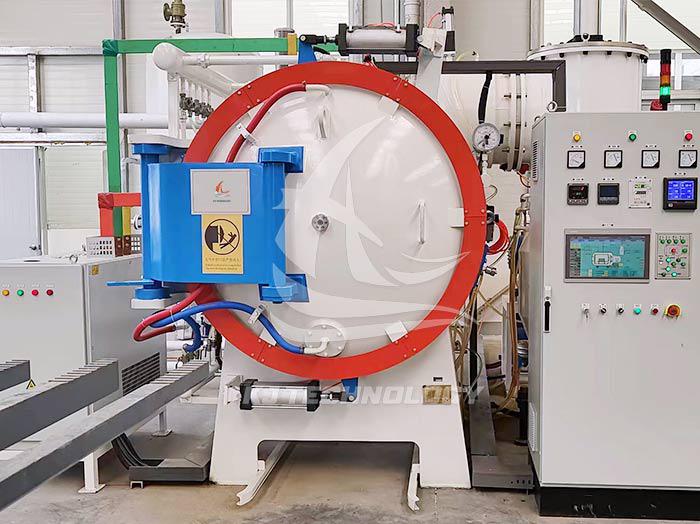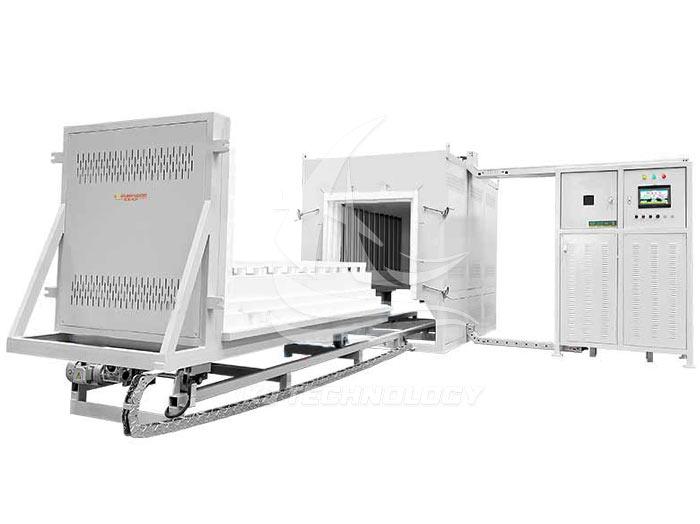Application scope of lab graphite vacuum furnace
 10-23-2025 Author: KJ technology
10-23-2025 Author: KJ technology
The laboratory graphite vacuum furnace plays a key role in multiple scientific and industrial fields due to its high temperature, vacuum or controllable atmosphere environment, and excellent material adaptability. The following is a detailed analysis of its core application scope:
1. Materials Science and Engineering
Preparation of Ceramic Materials
High temperature sintering: Under vacuum or inert atmosphere, high-density sintering of ceramics such as alumina, silicon nitride, and silicon carbide is achieved to avoid oxidation and improve material properties.
Reaction sintering: By controlling the atmosphere (such as nitrogen and hydrogen), the chemical reaction between ceramics and additives is promoted to generate new composite ceramics (such as Si ∝ N ₄ - SiC).
Transparent ceramics: Prepare high transmittance ceramics (such as YAG laser crystals) in a vacuum environment to reduce porosity and impurities.
Metal material processing
Melting of refractory metals: Melting high melting point metals such as tungsten, molybdenum, tantalum (melting point>2000 ℃) to prepare metal ingots with a purity>99.9%.
Alloy heat treatment: Annealing and quenching of nickel based high-temperature alloys and titanium alloys under vacuum to eliminate internal stress and optimize microstructure.
Powder metallurgy: Pressing metal powder and vacuum sintering to prepare densified parts (such as gears and bearings), reducing oxidation and porosity.
Composite material synthesis
Carbon/carbon composite materials: Immerse carbon sources under high temperature and vacuum to prepare lightweight and high-strength carbon fiber-reinforced carbon based composite materials (C/C) for aerospace brake discs.
Metal based composite materials: Ceramic particles (such as Al ₂ O3, SiC) are embedded into metal matrices (such as aluminum, magnesium) to enhance wear resistance and high-temperature stability through vacuum infiltration.
2. Semiconductor and Electronics Industry
crystal growth
Preparation of Monocrystalline Silicon: High purity silicon single crystals are grown using the Czochralski (CZ) method under vacuum or argon protection for use in integrated circuit substrates.
Silicon carbide (SiC) crystal: Growing 4H SiC single crystals in a high-temperature vacuum environment, it is a third-generation semiconductor material suitable for high-voltage and high-frequency devices.
Device packaging
Vacuum brazing: Welding electronic components (such as sensors and power modules) in an oxygen free environment to avoid poor contact caused by oxidation.
Airtight packaging: Vacuum packaging MEMS devices and infrared detectors to enhance reliability and lifespan.
thin film deposition
Chemical Vapor Deposition (CVD): Deposition of diamond films, graphene, and other materials in a vacuum furnace for cutting tool coatings or flexible electronics.
3. In the field of new energy and environmental protection
Lithium ion battery materials
Synthesis of positive electrode materials: Sintering lithium cobalt oxide (LiCoO ₂) and ternary materials (NCM/NCA) under vacuum or oxygen atmosphere, optimizing crystal structure to enhance capacity and cycling stability.
Negative electrode material treatment: Graphite negative electrodes are carbonized under vacuum to remove residual organic matter and improve initial efficiency.
Fuel cell catalyst
Preparation of platinum based catalysts: Reduction of chloroplatinic acid in a hydrogen atmosphere to prepare highly dispersed platinum nanoparticles for use as anodes in proton exchange membrane fuel cells (PEMFC).
Perovskite type catalyst: LaNiO3 and other perovskite oxides are synthesized by vacuum sintering as oxygen reduction reaction (ORR) catalysts.
Nuclear waste disposal
Glass solidification: Mixing and melting high-level radioactive waste liquid with glass raw materials under high temperature and vacuum to form a stable glass body and reduce the risk of radioactive material leakage.
4. Biopharmaceuticals and Chemicals
Preparation of Bioceramics
Hydroxyapatite (HA) sintering: Preparation of bioactive ceramics with similar composition to human bones under vacuum, used as bone repair materials.
Zirconia ceramics: High strength zirconia (3Y-TZP) is obtained through vacuum sintering and used as dental implant material.
Drug controlled release carrier
Synthesis of mesoporous silica: Preparation of ordered mesoporous structures under vacuum conditions, achieving sustained release function after drug loading.
High-temperature chemical reaction
Catalyst activation: Reduction of metal oxide catalysts (such as NiO/Al ₂ O3) in a hydrogen atmosphere to enhance hydrogenation reaction activity.
Organic pyrolysis: Decomposing plastic waste under vacuum to produce fuel oil or carbon materials.
5. Aerospace and Defense
High temperature structural materials
Ceramic matrix composites (CMC): Immerse silicon carbide matrix under vacuum to prepare turbine blade materials that can withstand temperatures above 1500 ℃.
Ultra high temperature ceramics (UHTC): sintered materials such as ZrB ₂ - SiC are used for the hot end components of hypersonic aircraft.
Special coating
Thermal barrier coating (TBC): YSZ (yttria stabilized zirconia) coating is sprayed under vacuum to protect engine blades from high-temperature oxidation.
Anti radiation coating: Deposition of hafnium or tungsten coating to shield spacecraft surface from cosmic rays.
6. Research and customized applications
Exploration of new materials
High throughput experiment: Combining vacuum furnace and rapid cooling device to screen new high-temperature alloys or superconducting materials.
In situ observation: Real time monitoring of material phase transition process through the combination of vacuum furnace and X-ray diffractometer.
small batch production
Jewelry processing: Smelting precious metals (such as platinum and palladium) under vacuum to avoid oxidation losses.
Art casting: firing high-temperature glass or ceramic sculptures to achieve complex shapes.








